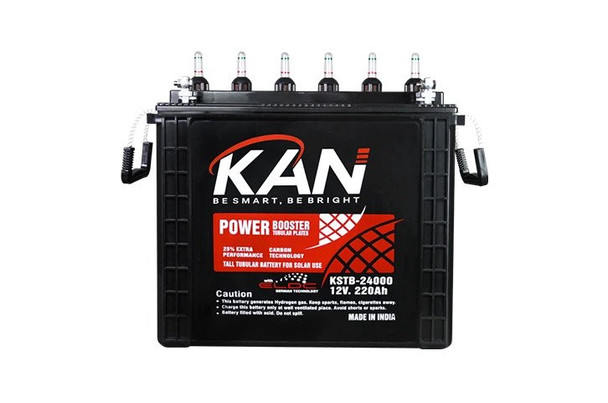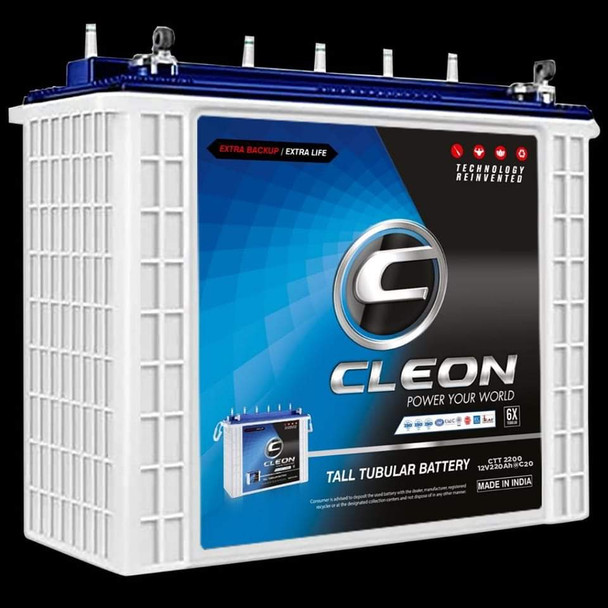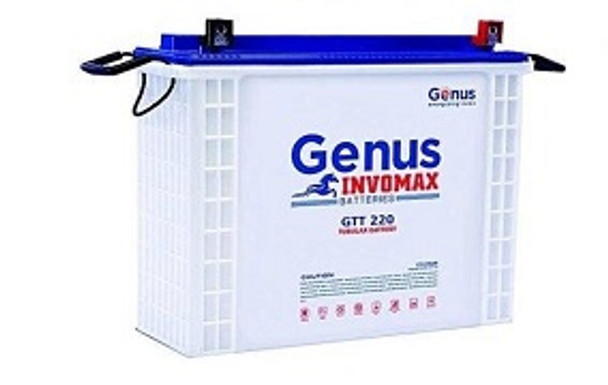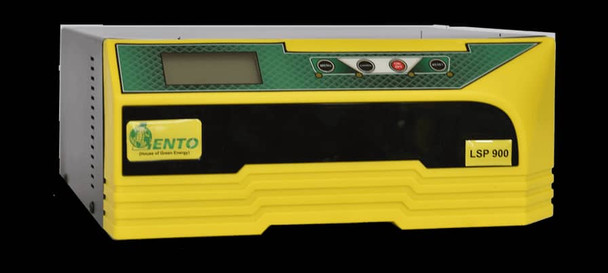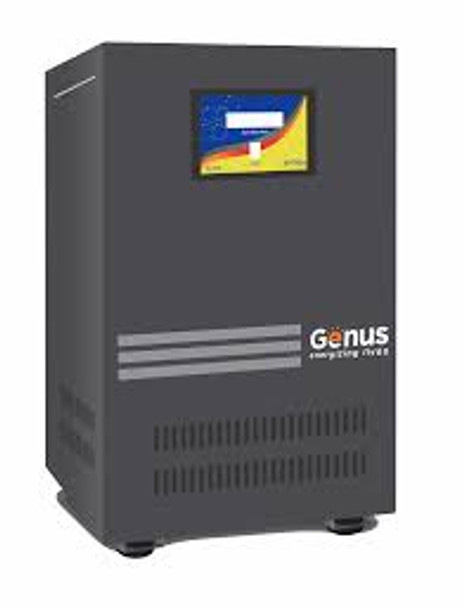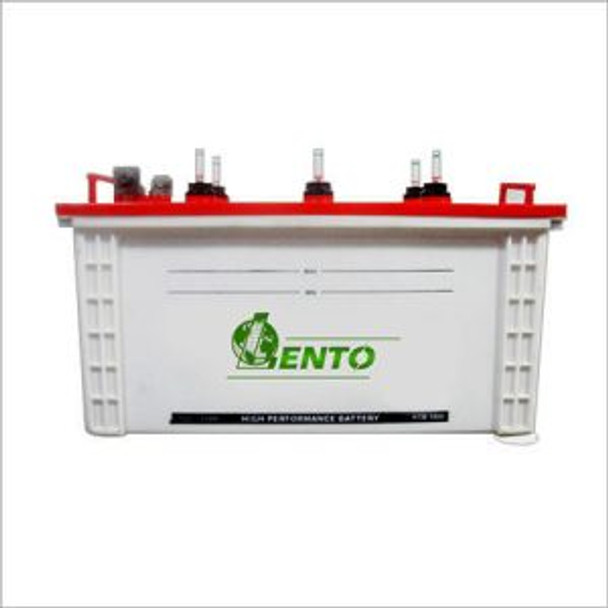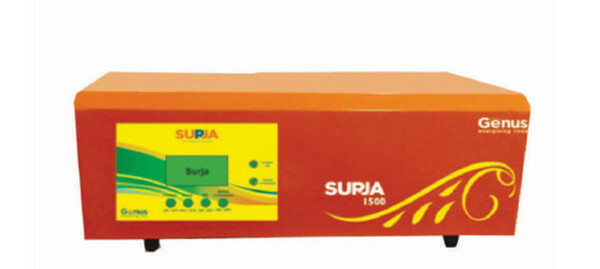How to Maintain Your Inverter Battery for Longevity
Ensuring the longevity of your inverter battery is essential for uninterrupted power supply. Embarking on a journey to maximize the lifespan and efficiency of your inverter battery requires a careful blend of diligence and know-how. Picture a scenario where your power backup seamlessly kicks in during outages, ensuring uninterrupted activities – this is the promise of a well-maintained inverter battery.
Buy Online... Kan 12v. 220AH Solar Tubular Battery
Regular charging stands out as a fundamental practice in the care and longevity of your inverter battery. Imagine it as a routine boost that rejuvenates the heart of your power backup system. In periods of inactivity, the battery can gradually discharge, leading to sulfation, a common issue that can compromise performance. By establishing a consistent charging routine, you prevent the battery from remaining in a discharged state for extended periods. This proactive approach not only fends off potential sulfation but also ensures that your inverter battery remains ready to spring into action when called upon. It's a simple yet effective strategy that pays dividends in sustaining the health and resilience of your power backup solution.
In the upcoming exploration, we will delve into practical and effective ways to keep your battery in prime condition. Discover practical tips and effective strategies in this guide on 'How to Maintain Your Inverter Battery for Longevity.' From simple care routines to insightful maintenance practices, empower yourself to maximize the lifespan of your inverter battery and enjoy reliable power backup whenever you need it.
Tips to Maintain Your Inverter Battery for Longevity
1. Regular Inspection and Cleaning
One of the most important steps to maintain your inverter battery for longevity is to inspect and clean it regularly. This will help you to detect and prevent any issues that may affect the performance and lifespan of your battery, such as corrosion, dust, dirt, or leakage. Here are some tips on how to inspect and clean your inverter battery:
Checking Battery Terminals
The battery terminals are the metal connectors that attach the battery to the inverter and the charger. They are essential for the flow of current to and from the battery. However, over time, the battery terminals may get corroded or rusted, which can reduce the electrical contact and increase the resistance. This can affect the battery voltage and current output, and cause the battery to charge slowly or discharge quickly.
To check the battery terminals, you should disconnect the battery from the inverter and the charger, and inspect them for any signs of damage, wear, or corrosion. You should also check the wires and cables that connect the battery terminals to the inverter and the charger, and make sure they are not loose, broken, or frayed.
To clean the battery terminals, you should use a solution of hot water and baking soda, and apply it to the corroded area with a toothbrush or a cloth. Scrub gently until the corrosion is removed, and then rinse with clean water and dry with a cloth. Also apply some petroleum jelly or Vaseline to the battery terminals, to prevent future corrosion and improve the electrical contact.
Ensuring Proper Ventilation
The battery generates heat during charging and discharging, which can increase the temperature of the battery and affect its efficiency and longevity. To prevent overheating and thermal runaway, which can damage the battery irreversibly, you will have to ensure proper ventilation around the battery. You should install the battery in a well-ventilated and insulated area, away from direct sunlight, heat sources, and flammable materials. You should also avoid placing the battery on the ground or near any metal objects, as they can conduct heat or electricity.
To ensure proper ventilation, check the battery vents and make sure they are not blocked or clogged by dust, dirt, or debris. You should also clean the battery vents regularly with a soft brush or a cloth, and remove any obstructions that may hinder the airflow and heat dissipation. You should also monitor the battery temperature and make sure it does not exceed 45°C, which is the maximum operating temperature for most inverter batteries.
Cleaning Battery Surface
The battery surface may get dirty or stained by dust, dirt, oil, or acid, which can affect the appearance and the performance of the battery. To prevent leakage, spillage, or short circuits, you should clean the battery surface regularly with a soft cloth or a sponge, and remove any dirt or stains that may accumulate on the battery. You should also check the battery for any cracks, leaks, or bulges, and replace the battery if you notice any signs of damage or deterioration.
To clean the battery surface, use a mild detergent or soap, and dilute it with water. You should avoid using any harsh or abrasive cleaners, such as ammonia, bleach, or vinegar, as they may damage the battery or cause corrosion. You should also avoid using any metal tools, such as knives, scissors, or screwdrivers, as they may scratch or puncture the battery. Gently wipe the battery surface with the detergent solution, and then rinse with clean water and dry with a cloth. You should also wear protective gloves and goggles, and avoid contact with the battery acid, as it may cause burns or irritation.
Buy Online Cleon Solar and Inverter Tall Tubular battery 12V 240AH
2. Monitoring Water Levels
Another essential step to maintain your inverter battery for longevity is to monitor the distilled water levels in the battery cells. This is especially important for lead-acid batteries, which are the most common type of inverter batteries. Lead-acid batteries consist of flat lead plates immersed in a pool of electrolyte, which is a solution of water and sulfuric acid. The water level in the battery cells affects the performance and lifespan of the battery, and should be checked and maintained regularly.
Learn more: Why Use Distilled Water For Inverter Battery
Importance of Water Levels in Lead-Acid Batteries
The water level in lead-acid batteries is important for two reasons:
- First, the water level determines the amount of electrolyte in the battery cells, which is essential for the chemical reactions that generate electricity. The water level should be high enough to cover the lead plates, but not too high to overflow or spill. If the water level is too low, the lead plates will be exposed to air, which can cause sulfation and corrosion, and reduce the battery capacity and efficiency. If the water level is too high, the electrolyte will dilute and leak, and cause damage to the battery and the surrounding area.
- Second, the water level affects the specific gravity of the electrolyte, which is a measure of the concentration of sulfuric acid in the solution. The specific gravity of the electrolyte indicates the state of charge of the battery, and should be within the recommended range for optimal performance. If the water level is too low, the specific gravity will be too high, which means the battery is overcharged and may overheat or gas. If the water level is too high, the specific gravity will be too low, which means the battery is undercharged and may freeze or sulfate.
How to Check and Maintain Adequate Water Levels
To check and maintain adequate water levels in lead-acid batteries, you should follow these steps:
- Always wear personal protective equipment, such as gloves, goggles, and long sleeves, when working with batteries, as the electrolyte is corrosive and can cause burns or irritation.
- Disconnect the battery from the inverter and the charger, and remove the vent caps or covers from the battery cells. Be careful not to spill or splash the electrolyte, and avoid contact with the battery terminals or wires.
- Use a flashlight or a hydrometer to inspect the water level in each cell. The water level should be about 1/2 inch above the tops of the plates, or just below the bottom of the vent well, to be considered in normal range. You can also use a hydrometer to measure the specific gravity of the electrolyte, and compare it with the manufacturer’s specifications or the color-coded chart on the hydrometer.
- If the water level is low, add distilled or demineralized water to each cell, until the water level reaches the normal range. Do not use tap water or battery acid, as they can contaminate or damage the battery. Do not overfill or underfill the battery, as they can cause leakage or poor performance.
- If the water level is high, drain some of the electrolyte from each cell, until the water level reaches the normal range. Do not dispose of the electrolyte in the drain or the trash, as it is hazardous and can harm the environment. Dispose of the electrolyte in a proper container, and take it to a recycling center or a hazardous waste facility.
- Replace the vent caps or covers on the battery cells, and reconnect the battery to the inverter and the charger. Charge the battery fully, and check the water level again after charging. The water level may rise slightly during charging, due to the gassing of the electrolyte, but it should not overflow or spill.
Be sure to check and maintain the water level in your lead-acid battery every month, or more frequently if you use the battery heavily or in hot climates. You should also check the water level before and after charging, and before and after long periods of storage. By monitoring the water level in your lead-acid battery, you can ensure its optimal performance and longevity.
Buy Online... Tubular Battery 220AH/12V Invomax Genus
3. Charging Practices
Another crucial step to maintain your inverter battery for longevity is to follow proper charging practices. This will help you to optimize the battery performance and lifespan, and prevent any damage or deterioration of the battery. Here are some tips on how to charge your inverter battery:
Optimal Charging Routine
The optimal charging routine for your inverter battery depends on the type, size, and usage of your battery. However, some general guidelines are:
- Charge your battery fully before using it for the first time, or after a long period of storage. This will help to activate the battery and improve its capacity and efficiency.
- Charge your battery regularly, and do not let it sit idle for too long. This will help to prevent sulfation and self-discharge, which can reduce the battery performance and longevity.
- Charge your battery according to the manufacturer’s instructions, and follow the recommended charging voltage and current. This will help to prevent overcharging or undercharging, which can damage the battery or cause poor performance.
- Charge your battery with the right charging equipment, such as a compatible inverter, charger, or solar panel. This will help to ensure the safety and quality of the charging process.
Avoiding Overcharging and Undercharging
Overcharging and undercharging are two common problems that can affect the performance and lifespan of your inverter battery. Overcharging occurs when the battery is charged beyond its full capacity, and undercharging occurs when the battery is not charged to its full capacity. Both of these can cause irreversible damage to the battery, such as:
- Overcharging can cause overheating, gassing, or swelling of the battery, which can lead to leakage, spillage, or explosion. Overcharging can also reduce the battery capacity and efficiency, and increase the water loss and corrosion.
- Undercharging can cause freezing, sulfation, or stratification of the battery, which can lead to reduced battery capacity and efficiency, and increased internal resistance and voltage drop.
To avoid overcharging and undercharging, you should:
- Use a battery management system (BMS) or a charge controller, which can monitor and control the battery parameters, such as voltage, current, temperature, and state of charge. A BMS or a charge controller can protect the battery from overcharging, undercharging, overheating, and short circuits, and optimize the battery performance and lifespan.
- Use a battery indicator or a hydrometer, which can show the state of charge of the battery, and indicate when the battery is fully charged or needs to be charged. A battery indicator or a hydrometer can help you to avoid overcharging or undercharging the battery, and maintain the optimal charge level of the battery.
Utilizing the Right Charging Equipment
The right charging equipment for your inverter battery depends on the type, size, and usage of your battery. However, some general guidelines are:
- Use a compatible inverter and charger for your battery, and make sure they have the same voltage and current ratings. This will help to ensure the safety and quality of the charging process, and prevent any damage or malfunction of the battery or the equipment.
- Use a solar panel or a generator to charge your battery, if you do not have access to grid power or if you want to save energy and money. This will help to provide a clean, renewable, and sustainable source of power for your battery, and reduce your dependence on grid power. However, you should also use a BMS or a charge controller to regulate the power output and input of the solar panel or the generator, and prevent any overcharging or undercharging of the battery.
Buy Online... Inverter Sine Wave 900VA / 12V Lento
4. Temperature Control
One of the key factors that affects the performance and lifespan of your inverter battery is the temperature. Temperature can have a significant impact on the chemical reactions, the internal resistance, and the capacity of your battery. Therefore, it is important to understand the impact of temperature on your battery life, and to implement measures for temperature regulation.
Understanding the Impact of Temperature on Battery Life
The optimal operating temperature range for most inverter batteries is between 15°C and 25°C. Within this range, the battery can function efficiently and effectively, and maintain its optimal charge and discharge rates. However, when the temperature deviates from this range, the battery can experience various problems, such as:
- High temperature: When the temperature exceeds 25°C, the battery can overheat and cause thermal runaway, which is a dangerous condition where the battery temperature and pressure increase uncontrollably and lead to fire or explosion. High temperature can also accelerate the chemical reactions and the water loss in the battery, which can reduce the battery capacity and efficiency, and increase the corrosion and sulfation.
- Low temperature: When the temperature falls below 15°C, the battery can freeze and cause irreversible damage to the battery plates and separators. Low temperature can also slow down the chemical reactions and increase the internal resistance in the battery, which can reduce the battery voltage and current output, and affect the battery performance and longevity.
Implementing Measures for Temperature Regulation
To prevent the adverse effects of temperature on your battery life, you should implement some measures for temperature regulation, such as:
- Installing a temperature sensor: A temperature sensor is a device that can measure and monitor the temperature of your battery, and send the information to your inverter or charger. This can help you to adjust the charging voltage and current according to the battery temperature, and prevent overcharging or undercharging the battery. Some inverters or chargers have a built-in temperature sensor, while others have an external temperature sensor that can be plugged in.
- Using a thermal management system: A thermal management system is a system that can control and regulate the temperature of your battery, using various methods such as air cooling, liquid cooling, or phase change materials. A thermal management system can help you to maintain the optimal temperature range for your battery, and prevent overheating or freezing of the battery. Some batteries have an integrated thermal management system, while others have a separate thermal management system that can be installed.
- Choosing a suitable location: The location of your battery can also affect the temperature of your battery, as it can be influenced by the ambient temperature, the sunlight, the airflow, and the heat sources. You should choose a suitable location for your battery, where you can avoid extreme temperatures, direct sunlight, heat sources, and flammable materials. You should also ensure proper ventilation and insulation around your battery, and avoid placing your battery on the ground or near any metal objects.
Buy Online... Inverter 3.5kva/48v Genus
5. Safe Storage Practices
If you are not using your inverter battery for a long period of time, such as during a vacation or a seasonal break, you should follow some safe storage practices to preserve your battery performance and lifespan. Here are some tips on how to store your inverter battery safely:
Storing Batteries in a Cool and Dry Place
The temperature and humidity of the storage place can affect the battery condition and performance. High temperature can cause overheating, gassing, or swelling of the battery, which can lead to leakage, spillage, or explosion. High humidity can cause corrosion, rust, or short circuits of the battery terminals or wires, which can reduce the electrical contact and increase the resistance. Therefore, you should store your battery in a cool and dry place, away from direct sunlight, heat sources, and flammable materials. The optimal storage temperature range for most inverter batteries is between 10°C and 25°C.
Ensuring Proper Ventilation During Storage
Even when the battery is not in use, it can still generate some heat and gas due to the chemical reactions and the self-discharge process. This can increase the temperature and pressure of the battery, and affect its efficiency and longevity. To prevent overheating and thermal runaway, you should ensure proper ventilation around the battery during storage. Install the battery in a well-ventilated and insulated area, and avoid placing the battery on the ground or near any metal objects. Also check the battery vents and make sure they are not blocked or clogged by dust, dirt, or debris. You should also monitor the battery temperature and make sure it does not exceed 45°C, which is the maximum operating temperature for most inverter batteries.
6. Periodic Professional Maintenance
Besides following the tips mentioned above, another important step to maintain your inverter battery for longevity is to seek periodic professional maintenance. By hiring a qualified and experienced technician or service provider to inspect, test, and repair your inverter battery, and to ensure its optimal performance and lifespan. Here are some reasons and considerations for periodic professional maintenance:
Importance of Professional Check-ups
Professional check-ups are important for your inverter battery for several reasons, such as:
- Detecting and preventing potential problems: Professional check-ups can help you to detect and prevent any potential problems that may affect your battery performance and lifespan, such as loose connections, faulty wiring, damaged components, or defective cells. A professional technician can use specialized tools and equipment, such as multimeters, load testers, or battery analyzers, to measure and monitor the battery parameters, such as voltage, current, resistance, capacity, and state of charge. They can also identify and fix any issues that may arise, such as corrosion, leakage, sulfation, or stratification, and restore the battery condition and performance.
- Enhancing safety and quality: Professional check-ups can help you to enhance the safety and quality of your battery and your power backup system, as they can ensure the proper installation, operation, and maintenance of your battery and your inverter. A professional technician can follow the manufacturer’s instructions and the safety standards, and avoid any risks or hazards that may occur during the battery handling, charging, or storage. And also use the right tools and materials, and avoid any errors or mistakes that may damage or harm the battery or the equipment.
- Saving time and money: Professional check-ups can help you to save time and money in the long run, as they can extend the battery life and reduce the battery replacement and repair costs. A professional technician can optimize the battery performance and efficiency, and prevent any premature or unnecessary battery failure or degradation. A professional technician can also advise you on the best practices and tips to maintain your battery, and provide you with warranty and support services.
Frequency and Considerations for Professional Maintenance
The frequency and considerations for professional maintenance depend on the type, size, and usage of your battery, as well as the environmental and operational conditions. However, some general guidelines are:
- Seek professional maintenance at least once a year, or more frequently if you use your battery heavily or in harsh climates. This will help you to keep your battery in good shape and performance, and to avoid any major problems or breakdowns.
- Seek professional maintenance before and after long periods of storage, or when you notice any signs of damage or deterioration, such as cracks, leaks, bulges, or low performance. This will help you to prevent any further damage or deterioration, and to restore the battery condition and performance.
- Seek professional maintenance from a reputable and reliable technician or service provider, who has the necessary qualifications, experience, and equipment to handle your battery and your inverter. You can check the reviews and ratings of the technician or service provider, and ask for references or recommendations from other customers. You can also compare the prices and services of different technicians or service providers, and choose the one that suits your needs and budget.
Buy Online... Lento Tubular Battery 220ah 12v
Troubleshooting and Early Detection in Inverter Batteries
Inverter batteries are the heart of your power backup system, and they require proper care and maintenance to function well and last long. However, sometimes, you may encounter some problems or issues with your inverter batteries, such as low performance, short backup time, or no power output. These problems may indicate that your inverter battery is faulty or damaged, and needs to be repaired or replaced. Therefore, it is important to troubleshoot and detect these problems early, and to address them promptly to prevent further damage and loss. Here are some tips on how to troubleshoot and detect inverter battery problems:
Identifying Signs of Battery Issues
The first step to troubleshoot and detect inverter battery problems is to identify the signs and symptoms that indicate that something is wrong with your battery. Some of the common signs and symptoms are:
- Dim or flickering lights: If your lights are dim or flickering when you use your inverter, it may mean that your battery is not providing enough power or voltage to your appliances. This may be due to low battery charge, high battery discharge, or poor battery connection.
- Reduced backup time: If your backup time is reduced or shorter than usual when you use your inverter, it may mean that your battery is not holding enough charge or capacity to run your appliances for long. This may be due to battery aging, sulfation, or water loss.
- Swollen or cracked battery: If your battery is swollen or cracked, it may mean that your battery is overheated or overcharged, and has experienced thermal runaway or gas leakage. This may be due to high ambient temperature, improper ventilation, or faulty charging equipment.
- Corroded or loose terminals: If your battery terminals are corroded or loose, it may mean that your battery is exposed to moisture or hydrogen, and has experienced electrical resistance or short circuits. This may be due to poor battery maintenance, improper battery installation, or faulty wiring or cables.
Addressing Problems Promptly to Prevent Damage
The second step to troubleshoot and detect inverter battery problems is to address the problems promptly and prevent further damage and loss. Some of the actions you can take are:
- Check and clean the battery terminals: If your battery terminals are corroded or loose, you should disconnect the battery from the inverter and the charger, and inspect and clean the terminals with a solution of hot water and baking soda. You should also check and tighten the wires and cables that connect the terminals to the inverter and the charger. You should also apply some petroleum jelly or Vaseline to the terminals to prevent future corrosion and improve the electrical contact.
- Check and maintain the water level: If your battery is a lead-acid battery, you should check and maintain the water level in the battery cells regularly. You should use a flashlight or a hydrometer to inspect the water level, and make sure it is about 1/2 inch above the tops of the plates, or just below the bottom of the vent well. You should also use a hydrometer to measure the specific gravity of the electrolyte, and compare it with the manufacturer’s specifications or the color-coded chart on the hydrometer. If the water level is low, you should add distilled or demineralized water to each cell, until the water level reaches the normal range. If the water level is high, you should drain some of the electrolyte from each cell, until the water level reaches the normal range.
- Check and adjust the charging voltage and current: If your battery is overcharged or undercharged, you should check and adjust the charging voltage and current according to the battery type, size, and state of charge. You should use a multimeter or a battery analyzer to measure and monitor the battery voltage and current, and compare them with the manufacturer’s specifications or the recommended range. You should also use a battery management system (BMS) or a charge controller to regulate and control the charging voltage and current, and protect the battery from overcharging, undercharging, overheating, and short circuits.
- Seek professional help: If your battery is swollen, cracked, or leaking, you should seek professional help immediately, and do not attempt to repair or use the battery yourself. You should also seek professional help if your battery is not working properly or showing signs of damage or deterioration, and you cannot identify or fix the problem yourself. You should contact the manufacturer or the service provider, and follow their instructions and recommendations. You should also dispose of the damaged or old battery in a proper way, and take it to a recycling center or a hazardous waste facility.
Eco-Friendly Disposal of Inverter Battery
Inverter batteries are the heart of your power backup system, and they require proper care and maintenance to function well and last long. However, sometimes, you may need to dispose of your old or damaged inverter battery, and replace it with a new one. When you do so, you should follow some eco-friendly disposal practices, to reduce the environmental impact and the health hazards of your battery waste. Here are some tips on how to dispose of your inverter battery in an eco-friendly way:
Sustainable Battery Disposal Practices
The best way to dispose of your inverter battery is to recycle it, rather than throwing it away in the trash or the landfill. Recycling your inverter battery can help you to conserve natural resources, save energy, and reduce greenhouse gas emissions. Recycling your inverter battery can also help you to recover valuable materials, such as lead, copper, and plastic, and use them to make new products. This helps you to prevent pollution, contamination, and fire hazards, caused by the leakage or explosion of the battery.
To recycle your inverter battery, you should take it to a qualified recycler or a collection point, who can handle your battery safely and responsibly. You can also contact your local government or waste management agency, and ask for their guidance and assistance. Also in some cases you can return your inverter battery to the manufacturer or the dealer, and ask for their recycling program or policy.
Before you recycle your inverter battery, you should prepare it properly, to avoid any risks or hazards during the transportation or the processing. Disconnect the battery from the inverter and the charger, and remove any accessories or attachments. Tape the battery terminals, and place the battery in a separate plastic bag or a cardboard box. You should also label the battery as hazardous or recyclable, and follow the instructions and regulations of the recycler or the collection point.
Reducing Environmental Impact
Besides recycling your inverter battery, you can also take some measures to reduce the environmental impact of your battery usage and disposal, such as:
- Choosing a suitable battery type and size: The type and size of your battery can affect the amount of materials, energy, and emissions involved in its production and disposal. Choose a battery type and size that suits your power needs and preferences, and avoids any waste or excess. For example, you can choose a lithium-ion battery, which has a higher energy density, a longer lifespan, and a lower environmental impact than a lead-acid battery.
- Using your battery efficiently and effectively: The way you use your battery can affect its performance and lifespan, and the frequency and the amount of your battery disposal. You should use your battery efficiently and effectively, and avoid any misuse or abuse. Follow the proper charging and maintenance practices, and prevent any overcharging or undercharging of your battery.
- Buying a certified or eco-friendly battery: The quality and the origin of your battery can affect the environmental and social impact of your battery production and disposal. Buy a certified or eco-friendly battery, which meets the standards and the criteria of environmental and social responsibility.
Buy Online... Inverter 1.5KVA/24V Surja Solar Genus
Related Article
The Best Inverter Battery in Nigeria 2023 Review
A Guide to Choosing Long-Lasting Inverter Batteries for Solar Systems
Conclusion
Inverter batteries are crucial components of power backup systems, demanding proper care and maintenance to ensure their optimal performance and extended lifespan. This article has delved into essential maintenance practices that can significantly preserve battery performance and longevity. These practices include regular inspection and cleaning, monitoring water levels, adhering to optimal charging practices, maintaining temperature control, implementing safe storage procedures, seeking periodic professional maintenance, and adopting eco-friendly disposal methods. By adhering to these guidelines, you can safeguard the longevity of your inverter battery, enjoy a reliable and efficient power backup system, save time and money, and mitigate the risks associated with battery failure or degradation. We hope this article has equipped you with the knowledge and insights necessary to maintain your inverter battery for optimal longevity. We encourage you to incorporate these practices into your battery maintenance routine to reap the long-lasting benefits. For more information or tips about maintaining your inver battery or if you are in the market to buy one, Contact Us Today
Recent Posts
-
Filing Machines for Welding: Features, Uses, and Best Models in Nigeria
IntroductionFiling machines are an essential part of welding, especially in precision work, metal fi …21st Oct 2024 -
Understanding Tubular Batteries: Benefits, Applications, and Maintenance
IntroductionTubular batteries have gained a solid reputation in the power backup and energy storage …19th Oct 2024 -
Choosing the Right Gear Oil: Types, Benefits, and Applications
Key TakeawayUnderstand Gear Types: Different gear systems (spur, helical, worm) require specific oil …16th Oct 2024


